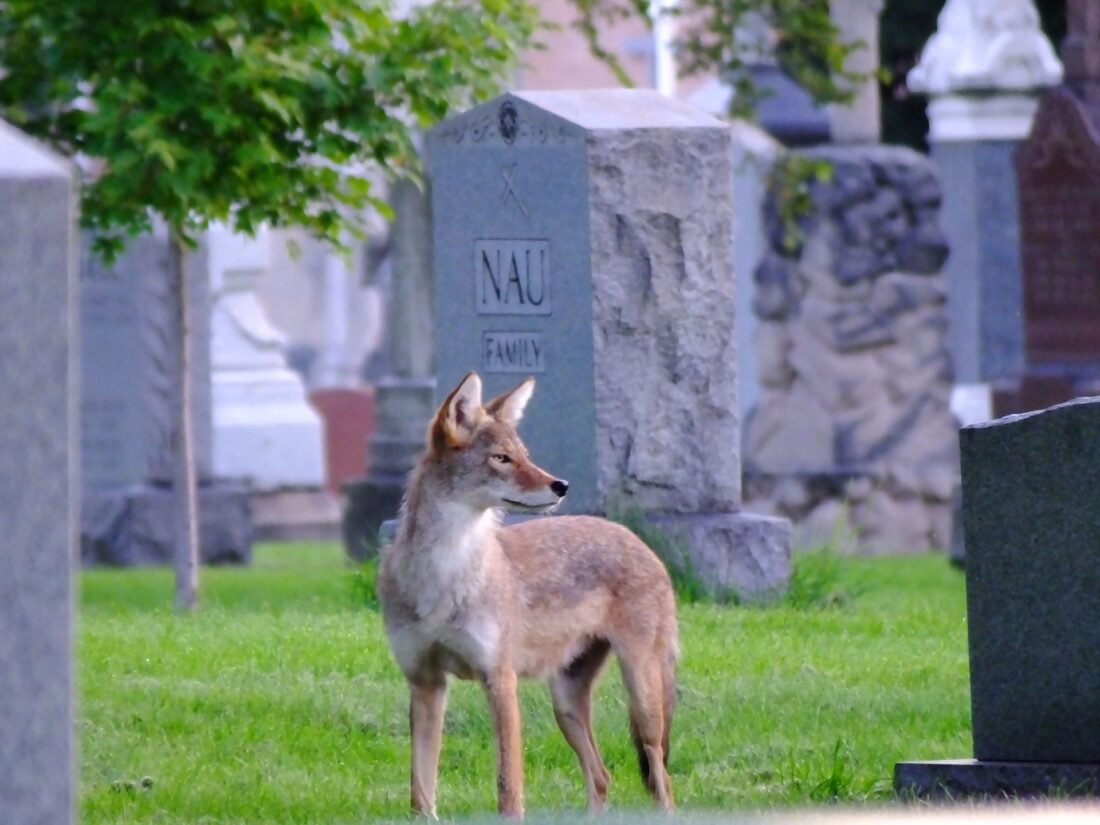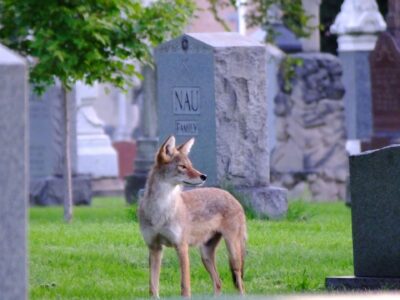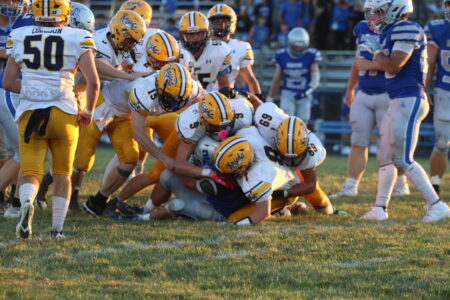Coyotes: Common in our area

Photo courtesy of Steve Sorensen The author called in and photographed this coyote in a small cemetery in Chicago.
Many easterners first became familiar with the singing canines when they howled and yipped through the speakers on our televisions in the 1950s and ’60s. It happened often on Rawhide, where Rowdy Yates and his crew sat around the campfire with Mushy’s chuck wagon as a backdrop. In those days we thought of coyotes as strictly western. Little did we know that we’d be hearing them through open bedroom windows in 2025.
A species that was once limited to western America is now everywhere. They’ve been seen on a commuter train in Portland, at Wrigley Field in Chicago, on a rooftop in New York City. The first recorded appearance of a coyote in Pennsylvania was longer ago than you might think, in 1938 near Ridgway, Pennsylvania.
Through the decades the Pennsylvania Game News magazine reported hundreds of sightings, so coyotes have been around here for a long time. Rural or urban areas, it doesn’t matter. They’re everywhere.
And they make a ruckus. People wake up and hear shrill song dog sounds coming through the open windows of bedrooms in rural homes and wonder what’s going on.
The answer is simple. The litters of coyotes born earlier this year are beginning to be independent. They’re learning to hunt. When one of them finds a reason to howl, others join in. Two or three can sound like 12 or 13. Maybe one of them caught a rabbit, perhaps even a fawn. It doesn’t take much to excite them, so it might be nothing at all. And they stop just as suddenly as they start.
Coyotes first arrived east of the Mississippi via a circuitous route. It’s in their nature to roam, and as coyotes advanced from the upper Midwest into Canada, they met an occasional timber wolf. Being of the same genus, canis latrans and canis lupus were able to interbreed and have fertile young. As wolf hybrids, eastern coyotes are larger than their western antecedents.
Where mates were scarce, they occasionally interbred with domestic dogs. However, dog characteristics are self-limiting. A female “coydog” (a hybrid domestic dog and coyote) might not come into heat at the proper time. In the wild, coyotes come into heat in early winter and give birth in late winter. That way, pups are old enough to survive the next winter. Female coydogs tend to come into heat on the more random schedule of domestic dogs. When born at the wrong time, coydog offspring are not likely to survive.
The expansion of coyotes from the upper Midwest and eastward above the Great Lakes and the genetic contribution of wolves has been documented in a 1995 book by Nova Scotia wildlife biologist Gerry Parker titled “Eastern Coyote: Story of Its Success”.
Once eastern Canada had a viable population of coyotes, the species expanded down into Maine, New York, New England and southward into Pennsylvania. The 1938 coyote in Pennsylvania fits the timeline.
For a long time, the biggest river in the United States was a barrier to eastward expansion, but coyotes finally surmounted the mighty Mississippi, came through the Midwest, and into Pennsylvania and southward, establishing the population throughout the eastern states. As of now, the only state that has no coyotes is Hawaii. It will be surprising if they don’t get there by being stowaways on a ship.
Nothing seems to inhibit coyotes. In fact, the more we try to kill them, the more they reproduce. The habitat in New York and Pennsylvania is now saturated–it holds all the coyotes it can. The average person seldom sees them, or sees evidence of them, and yet we have plenty of them.
Why don’t we see coyotes more often? Because they avoid us. Unlike wolves, which don’t do well close to people, coyotes do very well even where human populations are dense, but they seldom expose themselves to people. They live in America’s biggest cities, including at airports and in highway culverts. Estimates are that as many as 4,000 live in Chicago, which is why I was able to call one in and photograph it a few years ago, in a small cemetery inside the city of Chicago.
Have you seen a coyote? If you haven’t, it’s not because you haven’t been near one. They’re common, but they’d rather not be seen.
***
When “The Everyday Hunter” isn’t hunting, he’s thinking about hunting, talking about hunting, dreaming about hunting, writing about hunting, or wishing he were hunting. If you want to tell Steve exactly where your favorite hunting spot is, contact him through his website, www.EverydayHunter.com. He writes for top outdoor magazines, and won the 2015, 2018, and 2023 national “Pinnacle Award” for outdoor writing.




